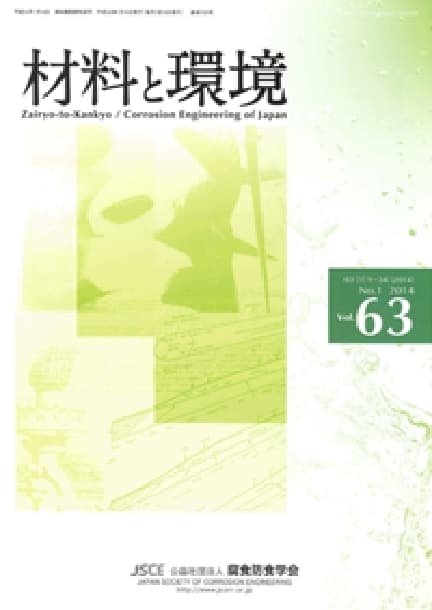- TOP
- Zairyo-to-Kankyo
- Vol. 58 (2009), No. 5
Zairyo-to-Kankyo Vol. 58 (2009), No. 5
Backnumber
-
Vol. 74 (2025)
-
Vol. 73 (2024)
-
Vol. 72 (2023)
-
Vol. 71 (2022)
-
Vol. 70 (2021)
-
Vol. 69 (2020)
-
Vol. 68 (2019)
-
Vol. 67 (2018)
-
Vol. 66 (2017)
-
Vol. 65 (2016)
-
Vol. 64 (2015)
-
Vol. 63 (2014)
-
Vol. 62 (2013)
-
Vol. 61 (2012)
-
Vol. 60 (2011)
-
Vol. 59 (2010)
-
Vol. 58 (2009)
-
Vol. 57 (2008)
-
Vol. 56 (2007)
-
Vol. 55 (2006)
-
Vol. 54 (2005)
-
Vol. 53 (2004)
-
Vol. 52 (2003)
-
Vol. 51 (2002)
-
Vol. 50 (2001)
-
Vol. 49 (2000)
-
Vol. 48 (1999)
-
Vol. 47 (1998)
-
Vol. 46 (1997)
-
Vol. 45 (1996)
-
Vol. 44 (1995)
-
Vol. 43 (1994)
-
Vol. 42 (1993)
-
Vol. 41 (1992)
-
Vol. 40 (1991)
Keyword Ranking
15 Dec. (Last 30 Days)
Zairyo-to-Kankyo Vol. 58 (2009), No. 5
The Points in Application of Post Construction Code from View Point of Corrosion in Japan
Yasuhiro Hara
pp. 170-175
DOI:
10.3323/jcorr.58.170Abstract
In the U.S and Europe, the post construction code, based on the ratiocinative and economic methods of maintenance have been developed. In Japan, having many aged equipment, the prompt improvement of post construction code is eagerly expected. This review indicates the summary of related corrosion items in American post construction code of RBI, FFS, and repair welding respectively, and the handling of flaws of high pressure gas security code in Japan in comparison to American post construction code. After that, the points in application of post construction code are shown in case of corrosion.
Modeling of Chemical Transition of Nitrate Accompanied with Corrosion of Carbon Steel under Alkaline Conditions
Akira Honda, Kaoru Masuda, Tsuyoshi Imakita, Osamu Kato, Tsutomu Nishimura
pp. 182-189
DOI:
10.3323/jcorr.58.182Abstract
Interaction between carbon steel and nitrate was modeled using the mixed potential concept. Carbon steel was selected as an example of metal components in the repository of radioactive wastes. The nitrate reduction accompanied with the corrosion of carbon steel was modeled as a reaction series of NO3– → NO2– → NH3. The sum of the current of the reaction series of NO3– → NO2– → NH3 and that of water reduction was assumed to be balanced with the oxidation current of carbon steel. The input parameters for this kinetic model were determined by electrochemical measurements and immersion tests. The results of the immersion tests can be interpreted by the analyses of the model.
Spallation of the Oxide Scale Formed on TiAl Alloys
Michiko Yoshihara, Yu Tanaka, Saburo Katayama
pp. 190-196
DOI:
10.3323/jcorr.58.190Abstract
The binary TiAl alloys and TiAl-based alloys were isothermally oxidized in air, and the oxidation behavior and scale spallation have been investigated. The mass gain due to oxidation of the TiAl-based alloys containing Nb, W or Ta is smaller than that of binary TiAl alloys, because of the suppression of TiO2 growth by the so-called doping effect. The TiAl-based alloys show better scale adhesion than binary TiAl alloys. Although the scales formed on the alloys have similar structure regardless of the alloy composition, the scale/alloy interface of the TiAl-based alloys seems to have good contact compared with that of the binary alloys. The densities of the oxide scales formed on the alloys estimated from the mass gain and the scale thickness are found to be about a half value of the expected one for the completely densified oxides. This is attributable to the formation of the large amount of cavities and pores in the scale. The coefficient of the thermal expansion (CTE) of the alloys decreases with increase of the content of additional elements in the alloy. The better scale adhesion of the TiAl-based alloys may result from the structure of scale/alloy interface and low CTE value of the alloys.
Article Access Ranking
15 Dec. (Last 30 Days)
-
Delayed Fracture Mechanism of 1700 MPa-Class Quenched and Tempered Bolt under Atmospheric Corrosion Environment
Tetsu-to-Hagané Advance Publication
-
Perspectives on the Promising Pathways to Zero Carbon Emissions in the Steel Industry toward 2050
ISIJ International Vol.65(2025), No.2
-
Effect of B on Surface Oxidation Behavior and Phosphatability of Si-Mn-added Cold-Rolled Steel Sheets
ISIJ International Advance Publication
-
Factors Influencing the Bonding Phase Structure of Iron Ore Sinters
ISIJ International Vol.43(2003), No.9
-
Effect of microstructural heterogeneity on fatigue limit of as-quenched low-carbon low-alloy martensitic steel
ISIJ International Advance Publication
-
Prussian blue as a fully reversible hydrogenochromic material for visualizing hydrogen distribution in Fe sheet
ISIJ International Advance Publication
-
Progress of Strip Casting Technology for Steel; Historical Developments
ISIJ International Vol.52(2012), No.12
-
Research Progress on Optimal Blending of Iron Ore Powders for Sintering
ISIJ International Vol.65(2025), No.12
-
-
Microstructures and Reduction Properties of High CaO Concentration Sintered Ore
ISIJ International Advance Publication
You can use this feature after you logged into the site.
Please click the button below.










